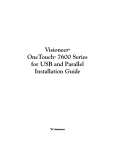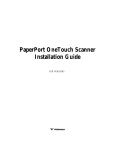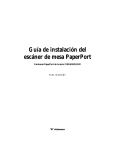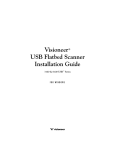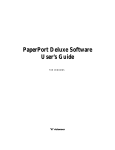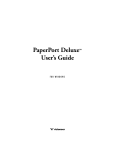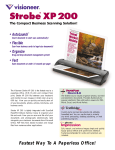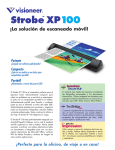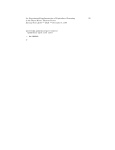Download Visioneer PROOCR100 Technical data
Transcript
Working with PaperPort FOR WINDOWS ® COPYRIGHT INFORMATION PaperPort 6.0™ software for Windows. Copyright ©1998 Visioneer, Inc. All rights reserved. Reproduction, adaptation, or translation without prior written permission is prohibited, except as allowed under the copyright laws. AnyPort, AutoFix, AutoLaunch, Visioneer® FormTyper, MicroChrome, PaperEnable, PaperLaunch, PaperPort, PaperPort Deluxe, PaperPort ix, PaperPort Links, PaperPort mx, PaperPort OneTouch, PaperPort PowerBar, PaperPort vx, PaperPortation, PaperPort Strobe, PaperPort 3000, PaperPort 3100, PaperPort 3100B, PaperPort 6000, PaperPort 6000A, PaperPort 6000B, PaperPort 6100, ScanDirect, SimpleSearch, SharpPage, Visioneer Pro OCR 100, and Visioneer are trademarks of Visioneer, Inc. PaperPort, Visioneer® Visual Explorer, and the Visioneer logo are registered trademarks of Visioneer, Inc. Microsoft is a U.S. registered trademark of Microsoft Corporation. Windows is a trademark of Microsoft Corporation. TextBridge is a registered trademark of Xerox Corporation. ZyINDEX is a registered trademark of ZyLAB International, Inc. ZyINDEX toolkit portions, Copyright © 1990-1996, ZyLAB International, Inc. All Rights Reserved. All other products mentioned herein may be trademarks of their respective companies. OutsideIn® Viewer Technology ©1992–1997 Inso Corporation. All rights reserved. Portions of this product were created using LEADTOOLS ©1991–1998, LEAD Technologies, Inc. All rights reserved. Powered by dtSearch. www.dtsearch.com Information is subject to change without notice and does not represent a commitment on the part of Visioneer, Inc. The software described is furnished under a licensing agreement. The software may be used or copied only in accordance with the terms of such an agreement. It is against the law to copy the software on any medium except as specifically allowed in the licensing agreement. No part of this document may be reproduced or transmitted in any form or by any means, electronic or mechanical, including photocopying, recording, or information storage and retrieval systems, or translated to another language, for any purpose other than the licensee’s personal use and as specifically allowed in the licensing agreement, without the express written permission of Visioneer, Inc. Part Number: 05-0369-000 Restricted Rights Legend Use, duplication, or disclosure is subject to restrictions as set forth in contract subdivision (c)(1)(ii) of the Rights in Technical Data and Computer Software Clause 52.227-FAR14. Material scanned by this product may be protected by governmental laws and other regulations, such as copyright laws. The customer is solely responsible for complying with all such laws and regulations. Visioneer’s Limited Product Warranty If you find physical defects in the materials or the workmanship used in making the product described in this document, Visioneer will repair, or at its option, replace, the product at no charge to you, provided you return it (postage prepaid, with proof of your purchase from the original reseller) during the 12-month period after the date of your original purchase of the product. THIS IS VISIONEER’S ONLY WARRANTY AND YOUR EXCLUSIVE REMEDY CONCERNING THE PRODUCT, ALL OTHER REPRESENTATIONS, WARRANTIES OR CONDITIONS, EXPRESS OR IMPLIED, WRITTEN OR ORAL, INCLUDING ANY WARRANTY OF MERCHANTABILITY, FITNESS FOR A PARTICULAR PURPOSE OR NON-INFRINGEMENT, ARE EXPRESSLY EXCLUDED. AS A RESULT, EXCEPT AS SET OUT ABOVE, THE PRODUCT IS SOLD “AS IS” AND YOU ARE ASSUMING THE ENTIRE RISK AS TO THE PRODUCT’S SUITABILITY TO YOUR NEEDS, ITS QUALITY AND ITS PERFORMANCE, IN NO EVENT WILL VISIONEER BE LIABLE FOR DIRECT, INDIRECT, SPECIAL, INCIDENTAL OR CONSEQUENTIAL DAMAGES RESULTING FROM ANY DEFECT IN THE PRODUCT OR FROM ITS USE, EVEN IF ADVISED OF THE POSSIBILITY OF SUCH DAMAGES. All exclusions and limitations in this warranty are made only to the extent permitted by applicable law and shall be of no effect to the extent in conflict with the express requirements of applicable law. FCC Radio Frequency Interference Statement This equipment has been tested and found to comply with the limits for the class B digital device, pursuant to part 15 of the FCC Rules. These limits are designed to provide reasonable protection against interference in a residential installation. This equipment generates, uses and can radiate radio frequency energy and if not installed, and used in accordance with the instructions, may cause harmful interference to radio communications. However, there is no guarantee that interference will not occur in a particular installation. If this equipment does cause harmful interference to radio or television reception, which can be determined by turning the equipment off and on, the user is encouraged to try and correct the interference by one or more of the following measures: • Reorient or relocate the receiving antenna. • Increase the separation between the equipment and receiver. • Connect the equipment into an outlet on a circuit different from that to which the receiver is connected. • Consult the dealer or an experienced radio/TV technician for help. This equipment has been certified to comply with the limits for a class B computing device, pursuant to FCC Rules. In order to maintain compliance with FCC regulations, shielded cables must be used with this equipment. Operation with non-approved equipment or unshielded cables is likely to result in interference to radio and TV reception. The user is cautioned that changes and modifications made to the equipment without the approval of manufacturer could void the user's authority to operate this equipment. This device complies with part 15 of the FCC Rules. Operation is subject to the following two conditions: (1) This device may not cause harmful interference, and (2) this device must accept any interference received, including interference that may cause undesired operation. Working with PaperPort This guide shows you how to use some of the PaperPort software’s main features to view items, create stacks, send items electronically to PaperPort Links, add annotations, file items in folders, capture Web pages, and edit color images. While this brief guide is enough to get you started, Visioneer provides other information to help you use all of the PaperPort software’s features. The following figure shows where to find more information. Web. Visit Visioneer’s Web site at www.visioneer.com where you can find Technical Notes, Frequently Asked Questions (FAQs), software updates, and more. For a quick way to access information on the Web site, choose a category from the Internet menu. User’s Guide. Review the online guide on the CD for detailed information about PaperPort. CD. Access the CD, your source for installing additional software that works with the Visioneer software and for viewing the online documentation. Help. Get help fast. Everything you want to know about PaperPort— how to procedures, dialog box reference, and troubleshooting advice. 1 2 WORKING WITH PAPERPORT VIEWING ITEMS IN DESKTOP VIEW PaperPort provides several ways to view items: Desktop View displays a thumbnail, a small graphic that represents each item in a folder. You can see PaperPort items (max files) and non-PaperPort items (items created using other applications, such as Microsoft Word) located anywhere on your computer. Page View displays a close-up of a single page. You can also start and use other applications directly from the Desktop View to view non-PaperPort items created in those applications. To view items in Desktop View: • Double-click the PaperPort icon on the Windows desktop. The Command Bar has shortcuts for choosing menu commands, such as changing views. Thumbnail of a PaperPort item. Thumbnail of non-PaperPort item, in this case a Word file. Use the Folder View to navigate between different folders and to file and organize items. Stacks are PaperPort items that have been combined. Stack titles appear in bold type above the page titles. Use the scroll arrow to view other links on the Link Bar. The status bar shows information about the selected item, link, or button. The Link Bar has icons that represent other applications and functions that work with PaperPort. The icons vary, depending on the applications installed on your computer. VIEWING AN ITEM IN PAGE VIEW 3 VIEWING AN ITEM IN PAGE VIEW The Desktop View and Page View are separate applications that you can run individually or at the same time. Page View displays a close-up view of one page so that it is readable on the screen. In Page View, you can view PaperPort items and items created using other applications. You can also adjust and edit the quality, color, and other aspects of a PaperPort image by using the Image Editing toolbar. With the annotation tools, you can add comments, highlight or circle information, or add a picture to a PaperPort item. To view a PaperPort item in Page View: • In Desktop View, double-click a PaperPort item or select a PaperPort item, and then click the Page button on the Command Bar. You can also double-click a PaperPort item in Windows Explorer to view it in Page View. To view a non-PaperPort item in Page View: • In Desktop View, Shift-double-click a non-PaperPort item, or select a non-PaperPort item, and then click the Page button on the Command Bar. Note: You can set a preference in Page View that lets you open multiple Page View windows at the same time. For more information about preferences, see the PaperPort User’s Guide and Help. 4 WORKING WITH PAPERPORT The Command Bar has shortcuts for menu commands. The Annotation toolbar has tools for adding notes, highlighting areas, cutting and pasting a selection, adding a picture, and so on. The status bar shows information about the current page. The Image Editing toolbar has tools for editing an image, improving the quality, or adjusting the color. To change between Desktop View and Page View: 1. In Desktop View, select the item you want. 2. Click the Page button. 3. To return to Desktop View, click the Desktop button. VIEWING ITEMS BY USING THE APPLICATION THAT CREATED THEM 5 VIEWING ITEMS BY USING THE APPLICATION THAT CREATED THEM From the Desktop View, you can start a non-PaperPort item’s application and use it to view the item. To view a non-PaperPort item in its application: • In Desktop View, double-click a non-PaperPort item. The application that created the item starts and the item appears. If you want, you can change the Double Click Action preference so that the item appears in Page View when you double-click it. For more information, see the PaperPort User’s Guide and Help. CREATING STACKS With PaperPort, you can electronically organize PaperPort items (including captured Web pages) into stacks in much the same way that you do with paper documents. A stack is a PaperPort item with multiple pages. You cannot stack non-PaperPort items. (However, you can easily convert a non-PaperPort item to PaperPort by right-clicking the item and choosing Duplicate as PaperPort Item.) To create a stack: 1. In the Desktop View, select the PaperPort item that you want to stack. This example shows stacking a Cover Letter on the Spring Vol 42 newsletter. Cover Letter Spring Vol 42 6 WORKING WITH PAPERPORT 2. Drag the selected item onto the PaperPort item on which you want to stack it. Cover Letter Spring Vol 42 3. When the second item is highlighted, release the mouse button. The stack is created. Spring Vol 42 Cover Letter 4. Repeat Steps 1 through 3 until you finish creating the stack. A new stack receives the title of the item on the bottom of the stack. The stack title (the name of the newsletter, “Spring Vol 2” in this case) is shown in boldface type. Each page title is shown in normal typeface (“Cover Letter” in the example). Note: When you select multiple items to stack, PaperPort stacks them in the order in which they were selected. MOVING BETWEEN STACKED PAGES 7 MOVING BETWEEN STACKED PAGES In Desktop View, use the Page Navigator on a stack to move through a stack’s pages. You can also use the First Page, Last Page, Previous Page, and Next Page commands on the Page menu to move from page to page. To move between pages in a stack in Desktop View: 1. Select the stack. 2. Click the left arrow of the Page Navigator to see the previous page in the stack. 3. Click the right arrow of the Page Navigator to see the next page in the stack, or click the middle of the Page Navigator to go to a specific page. To move between pages in a stack in Page View: 1. Display the stack. 2. Click the << Page or Page >> button. FAXING OR E-MAILING AN ITEM The PaperPort software is designed to work with—or link to—other types of applications. To send items to other applications, you use the Link Bar. The Link Bar automatically displays link icons for applications installed on your computer and supported by the PaperPort software, such as electronic fax, e-mail, image editing, and word-processing applications. 8 WORKING WITH PAPERPORT Note: You can change the link application preferences by choosing Link Preferences from the Edit menu. For more information, see the PaperPort User’s Guide and Help. After an item is displayed in Desktop View, you can send it as a fax, or as an attachment to an e-mail message, by using the Link Bar. You do not need to print the item first; you can send it directly from PaperPort. To fax an item, your computer must have a fax modem and fax software. To attach an item to an e-mail message, you need an e-mail account and e-mail software. To fax an item from Desktop View: 1. Select the item to fax. 2. Drag the item onto the fax link icon on the Link Bar. You can also click the item, and then click the fax link icon. FAXING OR E-MAILING AN ITEM 3. When your fax software starts, send the scanned item as a fax. This example shows the Symantec WinFax PRO window for sending a fax. The window that appears on your computer will be for your fax software. Note: To send an item to a link from Page View, choose Links from the File menu, and then choose the name of the link application. To send an item using an e-mail application: • Repeat the steps as described for faxing an item in the preceding procedure, except, drag the item onto your e-mail link icon on the Link Bar. If you are attaching items to an e-mail message, the e-mail software starts. After you log in, the item appears as an attachment to the e-mail message. Note: When you send an item as an e-mail message, you can make the message self-viewing. Recipients of the e-mail message can view the attached PaperPort item even if PaperPort is not installed on their computers. To create this type of e-mail attachment, choose Self Viewing Files as the Send Format in the Mail Links preferences, before you send the item. For more information, see the PaperPort User’s Guide and Help. 9 10 WORKING WITH PAPERPORT CONVERTING A PAPERPORT ITEM TO TEXT A PaperPort item is an image. Even the text on a scanned item is simply a picture of the text, and you can’t edit it as you would text in a wordprocessing document. If a supported word-processing icon such as Word appears on the Link Bar, you can use PaperPort to convert the item to text. The PaperPort software performs this conversion by using the built-in OCR (optical character recognition) software provided with PaperPort. After converting an image into text, you can edit the file by using a word-processing application, such as Word. To convert a PaperPort item to text from Desktop View: 1. Select the PaperPort item to convert. It can be a single page or a stack. 2. Drag the item onto the wordprocessing link icon on the Link Bar. You can also just click the wordprocessing link icon. 3. When the word- processing link icon is highlighted, release the mouse button. The OCR software displays a progress window while the conversion is in process. FILING ITEMS IN FOLDERS 11 Note: This example shows the steps for using PaperPort’s built-in OCR software and sending the converted text directly to Word. If you have other OCR software installed on your computer, you can convert the item by dragging the item to the OCR application on the Link Bar. 4. When the conversion is complete, the word-processing application opens, and you can begin editing the text. FILING ITEMS IN FOLDERS Desktop View provides an easy-to-use filing system for organizing your items. The filing system consists of folders shown in the Folder View and items shown on the Desktop. A folder that appears in the Folder View can be any folder located on your hard drive or located on a device attached to your computer, such as an external drive or disk. An item can be a PaperPort item or a non-PaperPort item, such as a Word file. You decide which folders to show in the Folder View. 12 WORKING WITH PAPERPORT With the PaperPort software, you can save items in separate folders similar to ordinary file folders, except that they are electronic. You can use folders to store and organize all your items. Although PaperPort has certain default folders, you can add new folders or change any folder’s title and color. The Visioneer Documents folder and these subfolders are provided with PaperPort. This folder, located on the C drive, was added to the Folder View. The items of one of the subfolders appear on the Desktop. FILING ITEMS IN FOLDERS 13 ADDING FOLDERS TO THE FOLDER VIEW Adding a folder to the Folder View lets you use PaperPort to see a folder and its items that are located on your hard disk or on another device connected to your computer. After you add a folder to the Folder View, you can view any of its folders or items in Desktop View. To add a folder to Folder View: 1. In Desktop View, choose Add to Folder View from the File menu. The Add to Folder View dialog box appears. It shows the same device and folder information that you see in Windows Explorer. 2. Select the folder on a drive or disk that you want to add to Folder View and click OK. The folder and its subfolders appear in the Folder View and items in the added folder appear on the Desktop. An icon identifies the folder as an added folder. In addition, the actual location of the folder on your computer, such as the C drive, appears in the folder title. Note: When you first add a folder to the Folder View, choose Refresh Thumbnails from the View menu. 14 WORKING WITH PAPERPORT To see the contents of a folder: 1. In the Folder View, click a Folder or click the plus sign next to a folder if one appears. Any subfolders included in the folder appear in the Folder View. Items appear on the Desktop. 2. Click a subfolder to display its contents. Any items in the folder appear on the Desktop. This example shows four items in the Newsletter folder, which is located in the Adventure Travel folder. Note: If you place an item into PaperPort, such as by scanning or capturing a Web page, the item is placed in the location that is currently selected in Desktop View. For example, if the Travel folder is selected and its items appear in Desktop View, then a scanned item is placed in the Travel folder. FILING ITEMS IN FOLDERS 15 FILING ITEMS IN FOLDERS BY USING DESKTOP VIEW You can use the folders to store and organize different items. The easiest way to move an item into a folder is by dragging and dropping the item. You can file items one at a time, or you can file multiple selected items all at the same time. To drag and drop an item into a folder: 1. Click an item to select it. Use Ctrl-click to select multiple items. 2. Drag the selected item onto a folder. 3. When the folder is highlighted, release the mouse button. To open a folder and see its contents, click the folder. Tip: To make a copy of an item and leave the original in its original folder, hold down the Ctrl key when dragging an item to a folder or select the item, and then choose Copy to Folder from the Desktop menu. CREATING A NEW FOLDER By adding new folders, you can create a set of folders that work best for different items, such as bills, expenses, memos, or personal and business correspondence. You can use PaperPort to create subfolders for any of the folders shown in the Folder View. 16 WORKING WITH PAPERPORT To add a folder: 1. Click the location in which you want to add a folder. 2. From the File menu, choose New, and then Folder. 3. Type the new folder’s title. 4. Select a color from the drop-down list, and then click OK. The new folder appears in the Folder View. Tip: To change a folder’s title, select the folder title in the list, and then click it again. Type the new title and press Enter. USING WINDOWS EXPLORER TO MANAGE ITEMS The previous procedures tell you how to work with folders and items from the Desktop View. You can also use Windows Explorer to complete changes, such as retitling a folder and filing items in different folders. The changes you make in Windows Explorer are directly reflected in Desktop View. Likewise, any changes you make in Desktop View are visible in Windows Explorer. FILING ITEMS IN FOLDERS To make changes in Windows Explorer: 1. In Desktop View, click the Explorer button on the Command Bar. Windows Explorer appears. 2. Use Windows Explorer to make changes to folders or items that appear in Desktop View. For example, you can retitle a folder or drag and drop items into different folders. You can also drag items from Windows Explorer directly to PaperPort. 17 18 WORKING WITH PAPERPORT CAPTURING WEB PAGES With PaperPort’s Web Capture, you can easily add Web pages directly to the Desktop View and automatically update them the next time you connect to the Internet. For example, you can capture information about your favorite stocks and then automatically update the Web page to reflect the latest numbers. Or visit a company’s Web site to get the latest product information. Tip: You might find it convenient to create a new folder that you can use to store all of your Web captures. To capture a Web page and display it in PaperPort: 1. In the Folder View, select the folder in which you want to add a Web page. 2. Connect to the Internet and then display the Web page that you want to capture. CAPTURING WEB PAGES 3. To capture only the visible portion of a page, click the Web Capture icon in the Windows taskbar, and then choose Capture Visible Portion. The Web page is saved as a special PaperPort item identified by your browser’s application icon. To capture an entire Web page that contains multiple screens of information, click the Web Capture icon in the Windows taskbar, and then choose Capture Entire Page. Each full screen of information is saved as a separate page in a stack. 19 20 WORKING WITH PAPERPORT To update a captured Web page: 1. Connect to the Internet. 2. In Desktop View, double-click the Web page item. A view of the Web page as it currently exists on the Internet appears. 3. To update the page, click the Web Capture icon, and then choose Capture Visible Portion or Capture Entire Page, depending on the currently captured Web page. A message appears asking if you want to update the page or create a new one. To update your current capture, click Update Existing. The page is updated. To create another Web page capture, (leaving the originally captured Web page as is), click Create New. A copy of the Web capture appears in Desktop View. Tip: To view a captured Web page in Page View, Shift-double-click the captured Web page item in Desktop View. If you make any changes to a captured Web page, you cannot automatically update it. ANNOTATING A PAGE 21 ANNOTATING A PAGE With the annotation tools, you can add a note, highlight text, draw lines or arrows, circle information, or paste a picture into a PaperPort item (including Web page captures.) For example, you might add a note that tells you when the item needs to be processed and returned to the sender. You cannot add annotations to non-PaperPort items. You add annotations by displaying an item in Page View and using the Annotation toolbar. All the annotation tools are used in the same manner; therefore, this section shows only how to use one tool. For more information about each tool and how to use it, see the PaperPort User’s Guide or the PaperPort Help. Note: In Desktop View, PaperPort displays small icons, such as an arrow or yellow note, on a page’s thumbnail for each annotation. To add an annotation: 1. In Page View, click the tool on the Annotation toolbar. 2. Place the cursor on the page. Its shape will indicate the tool you selected. 3. Depending on the tool you selected, click or drag the cursor to use the tool, such as to add a note. 22 WORKING WITH PAPERPORT ADJUSTING PICTURES Whether you are photographing houses for sale, displaying the newest model car, or just storing your favorite photographs as PaperPort items, you can edit these color or grayscale pictures using PaperPort’s imageediting tools. The Image Editing toolbar contains all of the tools for adjusting color as well as grayscale images. Note: The Image Editing tools work only with PaperPort items. A quick way to convert an image to a PaperPort item is to right-click the image, and then choose Duplicate as PaperPort item. IMPROVING PICTURES AUTOMATICALLY AutoFix Picture analyzes a picture and tries to improve that picture. PaperPort’s sophisticated internal system can adjust the color, brightness, and contrast to produce a good picture. AutoFix Picture works well to improve poor-quality pictures. Tip: To adjust the brightness, contrast, color, or tint of a picture, use the Adjust Picture command or the Picture wizard. For more information, see the next section, “Adjusting a picture yourself.” ADJUSTING PICTURES 23 To improve a picture automatically: 1. Display the picture in Page View. 2. Click the AutoFix Picture tool on the Image Editing toolbar, or choose AutoFix Picture from the Page menu. PaperPort begins adjusting the picture to improve its quality. Image Editing toolbar ADJUSTING A PICTURE YOURSELF Sometimes you have a photograph that is too light or too dark, or whose color is not right. If you prefer to make the adjustments and enhancements to a picture yourself, you can use the Adjust Picture command. When you select Adjust Picture, PaperPort displays samples of the original picture adjusted slightly. From the sample pictures, you can select the one you like best. If you don’t like any of these pictures, select one of the options, such as the Color option, and then adjust just the color. All the sample pictures adjust relative to the center picture. You can either select the sample picture you like best and save it or adjust the picture again. You can also click Undo All Changes and Undo Last Change to undo changes. 24 WORKING WITH PAPERPORT Tip: To learn how to use Adjust Picture, click the Wizard icon on the Image Editing toolbar. The Picture wizard shows you step-by-step how to adjust the brightness, contrast, tint, and color. To adjust and enhance a picture yourself: 1. Display the color picture in Page View. 2. Click the Adjust Picture tool on the Image Editing toolbar. The Adjust Picture dialog box appears. Original picture. Current picture. This picture has a dark blue border and appears in the center of the Adjust Picture dialog box. Options to change color, brightness, contrast, or tint. Adjustment slider for changing samples. ADJUSTING PICTURES 25 To adjust the color: 3. Select the Color option. 4. Drag the slider to the left for more color or to the right for less color. PaperPort adjusts all eight sample pictures. To select the picture you like best: 5. Click the picture that has the color you like best. It moves to the center and becomes the current picture. 6. To adjust another setting, repeat Steps 1 through 3. Click to undo the last change. 7. After you finish all adjustments, click OK to save the changes. When you select a picture, it moves to the center. All the other sample pictures change relative to the new current picture. If you don’t like the changes, click the Undo Last Change or Undo All Changes button to undo the changes. PaperPort does not save the settings, such as the amount of change, in the Adjust Picture dialog box; therefore, if you reopen the dialog box, the default settings appear. 26 WORKING WITH PAPERPORT Tip: If you want to ensure that your original picture is unchanged, make a copy of the picture by using the Duplicate Item command before opening the Adjust Picture dialog box. USING SIMPLESEARCH TO FIND ITEMS In addition to the standard methods of finding items by name, date, or keywords, a powerful PaperPort feature named SimpleSearch can find items based on the textual content. For example, if you remember only that the item included the word “California” or the phrase “…California coast,” SimpleSearch can find the item containing that word or phrase. To use SimpleSearch to find an item: 1. In Desktop View, choose Find Item from the Search menu. 2. Type the text to identify the item. 3. Select one or more checkboxes to identify where to search for the text. 4. Select the buttons to find just the first item, or all items that have that text. 5. Click Find. For more information about SimpleSearch and using Summary Information in a search, see the PaperPort User’s Guide and Help. SCANNING DIRECTLY TO A LINK APPLICATION WITH SCANDIRECT 27 SCANNING DIRECTLY TO A LINK APPLICATION WITH SCANDIRECT With ScanDirect, you can scan an item and send it to a linked application without starting PaperPort. ScanDirect is a control panel that runs in the background on your computer, and when minimized, the ScanDirect Control Panel icon appears on the Windows taskbar. Like PaperPort, you first select the target link that you want to use in ScanDirect and then scan the item to send it directly to that link application. The basic steps to use ScanDirect are the same for each application icon. The following example shows how to set the preferences for Photoshop, scan an item, and open that item in Photoshop. Note: To scan an item with your PaperPort flatbed scanner and send it to ScanDirect, you use the PaperPort Scan Manager dialog box. For more information, see the PaperPort User’s Guide and PaperPort Help. To use ScanDirect: 1. On the Windows desktop, doubleclick the ScanDirect shortcut. The ScanDirect control panel appears. Scan single page Scan to PaperPort Desktop Scroll arrows About ScanDirect Displays Scan Manager dialog box Scan multiple pages ScanDirect icons Help button Note: The Scan Single Page and Scan Multiple Page icons are not available for flatbed scanners, only sheetfed scanners. 28 WORKING WITH PAPERPORT 2. Right-click the Photoshop icon and choose Preferences. The Link Preferences dialog box appears. 3. Select the preferences and click OK. 4. Click the Photoshop icon on the control panel. 5. Click the button for scanning. If you have a TWAIN scanner, the button looks like this. Your image is scanned and appears in Photoshop. FILLING IN PREPRINTED FORMS WITH FORMTYPER 29 FILLING IN PREPRINTED FORMS WITH FORMTYPER In the past, you had to use a typewriter or a ballpoint pen to fill in the fields manually on preprinted forms. With the Visioneer FormTyper application, you can enter data by using your computer and then print the form. The end result is the preprinted form, filled with data just as if you had used a typewriter. To fill in a form: 1. Place a form in Desktop View, for example, such as by scanning the form. 2. Select the form, and then click the FormTyper link. FormTyper analyzes the form to find its fields and opens the FormTyper window. The fields are underlined in blue, and the cursor is at the first field to be filled in. 30 WORKING WITH PAPERPORT 3. Begin typing data if the cursor is at the first field that you want to fill in. To type in any other field, click the field. To add another line to a field, press Enter. 4. When you’re finished typing in a field, press the Tab key or the left or right arrow keys to move to the next field. 5. After completing the form, save it by choosing Save to PaperPort Desktop As from the Form menu. 6. Type a name for the filled-in form and click OK. The form appears on the Desktop. The “A” symbols indicate fields filled with text annotations. .
































